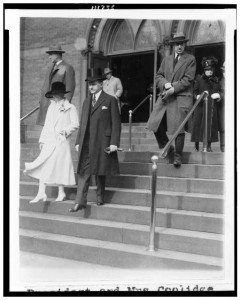By Rushad L. Thomas

If one crosses New England’s valleys and hills one will inevitably encounter ubiquitous clapboard Congregational meetinghouses. These places of worship crown the town greens of villages throughout the region. Their faith, the faith of the Puritan pilgrims, is a foundational element of the American ethos. Theirs is the faith of the first Thanksgiving, of Jonathan Edwards’ “Sinners in the Hands of an Angry God,” of the Salem witch trials, and of the heart and soul of the First Amendment: the freedom of religion (though most of the early Puritans came to the shores of British North America seeking religious freedom for themselves, not for others). Puritan Congregationalism has shaped the contours of American civic and religious life for hundreds of years.
President Calvin Coolidge, named for 16th century Protestant reformer John Calvin, was molded by this faith in the Green Mountains of Vermont. He describes his ancestors as “English Puritan stock” in his Autobiography, and notes the quiet but firm faith of his parents and grandparents that influenced his own spiritual direction:
“They kept up no church organization, and as there was little regular preaching the outward manifestation of religion through public profession had little opportunity, but they were without exception a people of faith and charity and of good works. They cherished the teachings of the Bible and sought to live in accordance with its precepts.”[1]
This simple, unpretentious Yankee faith marked President Coolidge throughout his life. During their years in the White House he and Mrs. Coolidge were regular parishioners at the First Congregational Church in Washington, D.C., a storied house of worship with a long tradition of commitment to the social gospel principles that have marked post-colonial Congregationalism. First Church helped found Howard University in 1867, and was one of the few racially integrated D.C. parishes of the era.
This spirit of social conscience was nurtured under the leadership of the Rev. Dr. Jason Noble Pierce, pastor of First Church during the Coolidge’s Washington years. Pierce served at First Church from 1920 to 1930, and, like President Coolidge, was an alumnus of Amherst College (Class of 1902). He served congregations in Massachusetts before being called to First Church in September 1920.
The Coolidges began worshiping at First Church from the time they arrived in D.C. as vice president and Second Lady of the United States in 1921. According to the First Congregational Church’s official history, the Coolidges were regular churchgoers, and were often joined by their sons Calvin, Jr., and John whenever they too were in Washington.
President and Mrs. Coolidge largely reflected that modest mode of religious expression exemplified by the Plymouth Notch of the president’s youth. In his Autobiography President Coolidge notes that one of the first things he did as president, in the hours after being notified of Warren Harding’s untimely death, was send a telegram to Dr. Pierce requesting a meeting with the cleric upon his arrival in Washington.[2] President Coolidge never divulged what counsel Dr. Pierce provided him at that time, but one can surmise that Coolidge likely called upon his pastor to seek the blessing of Almighty God for the facing of the hour, as he took up the heavy mantle of the presidential office.
Dr. Pierce and his congregation welcomed the Coolidges with open arms. Despite the inevitable security challenges accompanying a presidential parishioner, church members were delighted to have the First Family within their fold. The Coolidges attended First Church nearly every Sunday during his presidency, although President Coolidge never formally joined the church. It was Dr. Pierce who put the question of Coolidge’s church membership to a vote of the congregation after the president partook of the Lord’s Supper in their communion service. They acknowledged this act of faith and extended membership to the president.[3] Of this, President Coolidge wrote:
“Had I been approached in the usual way to join the church after I became President, I should have feared that such action might appear to be a pose, and should have hesitated to accept. From what might have been a misguided conception I was thus saved by some influence which I had not anticipated…Fate bestows its rewards on those who put themselves in the proper attitude to receive them.”[4]
Coolidge’s accession to the membership of First Church was noted in the New York Times, which also reported that the National Convention of the Congregational Church also unanimously named Coolidge its Honorary Moderator, a position Coolidge was pleased to accept.[5] In a telegram to the national convention Coolidge wrote “The strength of religion is the strength of the State. Your devotion to the cause of righteousness is a guarantee of the permanent security of our institutions.”[6]
Dr. Pierce understood President Coolidge’s humility, and welcomed him into his flock in the most unostentatious way possible. This reflects well upon the overarching spirit of Calvin Coolidge’s religious faith: humble, quiet, never boastful, but very deeply felt. Coolidge valued his faith and the traditions from which it sprang, and he never ceased to extol the virtues of religious belief and practice among the American people during his time in the White House. His dedication to our civic religion continues to be admired by many to this day.
References
[1] Autobiography of Calvin Coolidge, p. 19-20.
[2] Autobiography of Calvin Coolidge, p. 178.
[3] Everett O. Alldredge, Centennial History of First Congregational Church 1865-1965
[4] Autobiography of Calvin Coolidge, p. 180.
[5] “Coolidge Becomes Member of Church: Formally Elected by First Congregational in Washington—Joining Dates from Aug. 5,” New York Times, October 19, 1923.
[6] “Church Council Honors Coolidge: Congregationalists Make Him Honorary Moderator—Favor Union with Presbyterians,” New York Times, October 18, 1923.